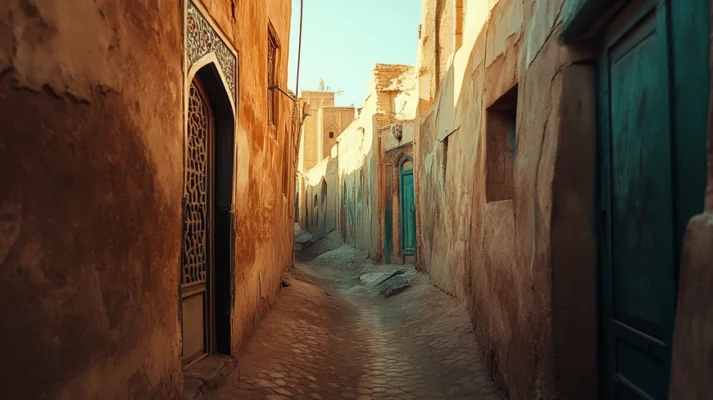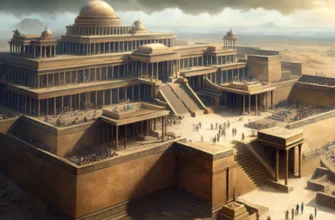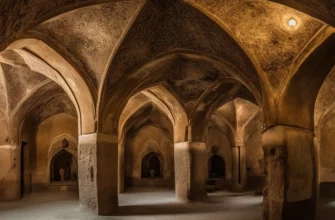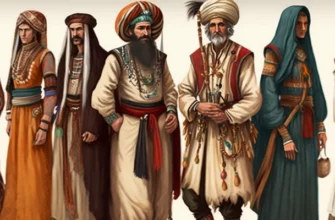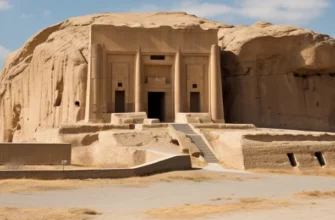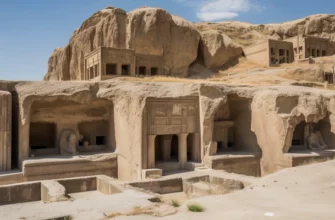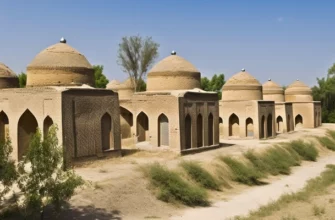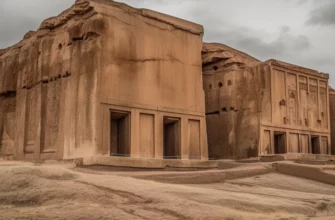Yazd is one of the oldest cities in Iran, located on the edge of the Dasht-e Kavir desert. The city is known for its unique clay architecture, labyrinthine narrow streets, and traditional cooling system called badgirs, or wind towers.
Yazd has a history dating back thousands of years. The city was of particular importance to Zoroastrians, followers of one of the oldest monotheistic religions. The Ateshkadeh fire temple, where fire has been burning continuously for over a thousand years, is still in operation here. Outside the city, the so-called Towers of Silence, where Zoroastrians performed funeral rites, have been preserved.
Yazd is not only a center of ancient culture, but also an example of harmony between humans and the desert environment. In 2017, the historic center of the city was included in the UNESCO World Heritage List.
Today, Yazd attracts tourists from all over the world, preserving the spirit of antiquity and the hospitality of its inhabitants.
History of Yazd
The history of Yazd goes back thousands of years — archaeological finds show that this area was settled as early as the third millennium BC. Thanks to its location between the Desert of Khor-e-Qavir and the Desert of Lut, the city became an important trading center and a safe haven during wars.
During the Sassanid Empire (3rd–7th centuries), Yazd was an important religious center of Zoroastrianism, one of the oldest monotheistic religions. It is here that the Fire Temple, where the sacred fire has been burning for over a thousand years, has been preserved.
After the Arab conquest of Iran in the 7th century, Yazd managed to preserve its unique identity and religious traditions. In the Middle Ages, the city became a center for silk and textile production and retained its status as a cultural and economic center.
Despite changes in power and time, Yazd has managed to preserve its architecture, traditions, and spirit of antiquity. It is one of the few cities where the Zoroastrian community is still active and where the past is closely intertwined with the present.
The first settlements on the territory of modern Yazd appeared as early as the third millennium BC. Thanks to its strategic location between two deserts, the city became an important point on trade routes, in particular the Silk Road.
Zoroastrianism and the Sassanids:
During the Sassanid Empire (224–651 CE), Yazd gained religious significance as a center of Zoroastrianism.
It was home to the Ateshgah fire temple, where, according to legend, a fire has been burning continuously for over 1,500 years. Even after the Islamic conquest in the 7th century, the city remained a refuge for Zoroastrians seeking protection from religious persecution.
Mongol rule (13th century):
During the Mongol invasion led by Hulagu Khan, Yazd, like many cities in Iran, was destroyed. However, thanks to flexible diplomacy, the local authorities achieved relative peace, and the city retained its economic potential. During this period, crafts such as pottery, weaving, and silk production developed.
Yazd under the Safavids (16th–18th centuries):
During the reign of the Safavid dynasty, the city experienced a new heyday. Shiite Islam became the state religion, but Zoroastrians in Yazd were allowed to maintain their traditions within separate quarters. The city was actively built up, with new mosques, madrasas, and caravanserais appearing.
Modern times and the present day:
In the 19th–20th centuries, Yazd retained its status as an important regional center. Its unique water supply system (canals), clay buildings, wind towers, and cultural heritage attracted the attention of architects and researchers. In 2017, the historic center of Yazd was added to the UNESCO World Heritage List.
Today, Yazd is not only an open-air museum but also a living city where Zoroastrian, Muslim, and Persian traditions coexist in harmony. Tourism, crafts, and cultural festivals are restoring Yazd to its former glory.
Architecture and urban planning
Yazd impresses with its unique architecture, which harmoniously combines functionality and aesthetics, adapting to the harsh desert climate. The city is built of unfired clay (adobe), which perfectly keeps it cool during the hot days and warm at night.
The old town is a labyrinth of narrow, winding streets, high walls, and traditional courtyards. This structure not only served as protection from the heat and dust storms but also ensured the safety of residents in turbulent times.
One of the most recognizable features of Yazd is the badgirs, or wind towers. This is an ancient natural ventilation system that directs the slightest breeze down into the houses, cooling the rooms without any electricity.
Qanats are another engineering marvel: underground channels that bring water from the mountains to the city, preventing evaporation. It is thanks to them that Yazd has been able to exist in the arid desert for centuries.
The city also has numerous mosques, khammas, caravanserais, as well as Zoroastrian fire temples and towers of silence, which give the architectural landscape a special sacred meaning.
Yazd is an example of the perfect symbiosis between humans and the natural environment. Its architecture is a living heritage that has not only been preserved but continues to function in the daily lives of its inhabitants.
Clay buildings and ancient quarters
Yazd is one of the few cities in the world where almost the entire historic center is built of clay. The main building material here is adobe, a mixture of clay, straw, and water that is dried in the sun. This material is not only cheap and environmentally friendly, but also ideal for the harsh desert conditions, protecting against the heat during the day and the cold at night.
The houses traditionally have high, thick walls, inner courtyards with gardens or fountains, and domed roofs that improve air circulation. Due to the uniform color of the walls — a soft sandy-clay color — the entire old town of Yazd looks like a single organic space.
One of the most famous ancient districts is the Fahadan quarter, a veritable open-air museum. Here you can find houses dating back several centuries, narrow streets with arches, historic khammas, madrasas, mosques, and Zoroastrian buildings. A walk through these streets is like a journey back in time.
The clay buildings are not only part of everyday life but also a cultural heritage that shows how architecture can be adapted to nature without disturbing its balance.
Badgirs – wind towers
Badgirs, or wind towers, are one of the most striking examples of traditional Persian architecture, especially common in Yazd. These architectural structures served as a natural air conditioning system long before the advent of electricity.
A badi looks like a tall tower with openings in several directions. Its principle of operation is simple and ingenious:
when the wind blows, it enters the tower, flows down special channels, and cools the interior of the house. Even in calm weather, warm air rises, creating natural ventilation.
In Yazd, these towers can be seen on almost every old house, hammam, or mosque. The most famous example is the wind tower at the Dovlat-Abad complex, which is about 33 meters high — the tallest badgir in Iran.
Badgirs are not only functional but also aesthetically appealing. Their shapes, patterns, and symmetry have become a hallmark of the city. They prove that the ancient inhabitants of Yazd knew how to live in harmony with nature, using its forces to their advantage.
Fire temples and religious buildings
Yazd is the spiritual center of Zoroastrianism, one of the world’s oldest monotheistic religions. The city has preserved numerous religious buildings, among which fire temples occupy a special place. These are sacred places where the “eternal fire” burns, symbolizing purity, truth, and divine light.
The most famous of these is Ateshkadeh Yazd (or Zoroastrian Fire Temple), built in the 1930s, but according to legend, the fire has been burning continuously since the 5th century. Only Zoroastrians are allowed to enter the temple, but tourists can see the sacred flames through the glass. This place still serves as the spiritual center of the Zoroastrian community.
In addition to fire temples, Yazd has many mosques that impress with their beauty and detail. Among them is the Jameh Mosque (14th century), with a huge portal, turquoise mosaics, and two minarets, which are among the tallest in Iran.
Another unique feature is the Towers of Silence (Dakhma) on the outskirts of the city. In the Zoroastrian tradition, the deceased were left on these round stone platforms to decompose naturally under the sun and birds. Although no longer practiced, this ritual remains a powerful symbol of faith and connection with nature.
The religious architecture of Yazd is not only a collection of religious buildings, but also a living testimony to thousands of years of tradition and the tolerant coexistence of different religions.
Jameh Mosque — the pearl of Islamic architecture in Yazd
Jameh Mosque (Jameh Mosque of Yazd) is the main mosque of the city, a masterpiece of 14th-century Persian architecture, built on the site of an ancient Zoroastrian temple. It is not only a religious center but also a symbol of Yazd.
The mosque impresses with its tall minarets (about 52 m), which are among the highest in Iran, and a monumental portal decorated with intricate turquoise and blue mosaics. Calligraphic patterns, geometric ornaments, and arches create a sense of grandeur and spiritual depth.
Inside is a spacious prayer hall with a dome that changes color in the sunlight. The building has unique acoustics: even a whisper in the center of the mosque can be heard near the walls. The Jameh Mosque is not only a place of worship but also a living museum of Islamic art and architecture.
Towers of Silence — mysterious Zoroastrian rituals
On the southern outskirts of Yazd, among the rocky hills, are the Towers of Silence (Dakhma) — round stone structures that Zoroastrians used for burial rituals until the 20th century.
According to Zoroastrian beliefs, earth, water, and fire are sacred and therefore cannot be defiled by the bodies of the dead. To adhere to this principle, bodies were left on special platforms in the Towers of Silence, where they were left to decompose naturally under the sun and were eaten by birds of prey, mainly vultures.
Although this ritual is no longer practiced (it was officially banned in the 1970s), the Towers of Silence have been preserved as monuments to ancient spiritual traditions. They are still held in high esteem and attract interest today, as they reflect the ecological thinking of ancient times.
Beneath the towers are old Zoroastrian residential quarters, schools, wells, and a hall for preparing the body for the ritual, all of which are open to visitors.
Cultural heritage and traditions
Yazd is one of the oldest cities in Iran, with a rich cultural heritage and deep roots in the country’s history. Located in central Iran, the city is known for its unique architecture, which harmoniously combines the traditions of Zoroastrianism and Islamic culture. Here are some of the main aspects of Yazd’s cultural heritage and traditions:
Zoroastrianism:
Yazd is an important center of the Zoroastrian religion. Zoroastrianism is one of the oldest known religions, which originated in Iran about 3,500 years ago. Yazd is home to one of the main fire temples, where a sacred flame burns continuously.
Fire Temple: The Atar Tekke Fire Temple, or Yazd Fire Temple, is an important place of worship for Zoroastrians.
Zoroastrian holiday traditions: Yazd is the site of important religious holidays such as Nowruz (Persian New Year), which is celebrated with grand religious ceremonies.
Architecture and urban planning:
The city is known for its unique architectural heritage, including traditional buildings made of clay and brick, which are well adapted to the harsh desert climate. There are numerous mosques, madrasas (Islamic schools), and ancient buildings.
Towers of Silence (Dakhma): These are architectural structures where Zoroastrians traditionally left the bodies of their dead to be consumed by birds. These towers are important elements of Zoroastrian culture and symbolize purification and liberation from the physical.
Jameh Mosque: A large mosque that is one of the oldest and most important architectural monuments in Iran.
Cuisine and culinary traditions:
The culinary traditions of Yazd also reflect the richness of its cultural heritage. Dishes made with local ingredients such as spices, nuts, and fruits are characteristic of this region.
Shirazi: This is a traditional Iranian dish popular in Yazd, made with meat, rice, and spices.
Dried fruits and nuts: These are widely used as part of festive meals.
Music and dance:
Yazd is famous for its folk music, which is an integral part of cultural celebrations. Traditional instruments such as the santur (a stringed instrument) and the darbuka (a percussion instrument) are often used to perform classical melodies.
Textiles and crafts:
Yazd is also famous for its handicrafts, particularly weaving and carpet making. Fabrics from Yazd are known for their high quality, and local artisans preserve traditions that have been passed down from generation to generation.
Nowruz celebrations:
Nowruz is the Persian New Year, celebrated with great fanfare in Yazd. This holiday symbolizes the rebirth of nature and a new cycle of life. In Yazd, Nowruz celebrations have unique features, including ritual ceremonies, songs, dances, and gastronomic traditions.
Yazd not only preserves its cultural heritage but is also an important center where ancient traditions live on in modern Iran.
Local crafts and arts
Yazd is a city where traditional crafts and arts occupy an important place in the cultural heritage. Thanks to its location in a desert region and its historical context, Yazd’s crafts have developed in a unique atmosphere that combines ancient traditions and influences from different cultures. Here are some of the main crafts and arts typical of Yazd:
Carpet weaving and weaving:
Yazd is famous for its carpet weaving traditions, which date back centuries. Local carpets are renowned for their high quality and craftsmanship. The carpet-making craft in Yazd is distinguished from carpets from other regions of Iran by its unique techniques and motifs, which often include elements of Zoroastrian symbolism and stylized natural images.
Yazd carpets feature distinctive geometric embroidery and the use of deep red, blue, and gold colors.
The production of traditional woven carpets involves complex hand techniques that are a symbol of the deep craftsmanship of the region’s artisans.
Pottery:
Pottery in Yazd is another important craft that has been preserved to this day. Local artisans produce a variety of clay products, from tableware to decorative items. Pottery from Yazd is known for its elegance and high quality.
Clay pottery: Local artisans often use clay to make pottery, which is common in many regions of Iran. This pottery has simple but elegant shapes and is often painted with traditional patterns.
Pottery is often covered with natural glazes, which gives it a unique look.
Embroidery and textiles:
Embroidery is an important aspect of Yazd culture. Local embroiderers create beautiful fabrics that are used for both everyday needs and festive ceremonies.
Embroidery often includes intricate geometric patterns or symbols that have cultural and religious significance.
Textiles from Yezd include both household items and items for religious ceremonies, such as altar cloths or decorative elements for festivals.
Metalworking:
A tradition of metalworking has developed in Yezd, particularly in the manufacture of jewelry and decorative metal objects. Local craftsmen work with gold, silver, copper, and bronze to create elegant jewelry that often has religious or cultural significance.
Jewelry from Yazd is renowned for its intricate craftsmanship and beautiful details, as well as its unique inlay techniques and delicate ornamentation.
In addition, Yazd’s craftsmen produce other metal objects such as lanterns and decorative elements for architecture.
Traditional painting:
Yazd also preserves traditions of painting, especially in the context of religious and cultural works. Yazd artists create paintings depicting scenes from Iranian history, Zoroastrian symbols, and religious motifs.
Iranian miniature painting: Yazd has a tradition of miniature painting, often depicting historical scenes, episodes from the lives of saints, or images of landscapes and nature.
Calligraphy:
Calligraphy is an important element of Iranian art, and Yazd is no exception. Literary works, particularly poetry, are often written in exquisite calligraphic script.
Calligraphy is used to decorate books, sacred texts, and architectural elements in mosques and other buildings.
Music and dance:
Local music and dance are also part of Yazd’s crafts and are often used in festive events. Traditional instruments such as the santur (a stringed instrument), the darbouka (a percussion instrument), and the kobuz (a stringed instrument) are used to perform musical compositions that convey the spirit of this cultural tradition.
In this way, the crafts and arts of Yazd preserve centuries-old traditions and are an important element of the local culture, contributing to the preservation of Iran’s national heritage.
Conclusion
Yazd is one of Iran’s most important cultural and historical centers, playing a significant role in the preservation and development of Iranian heritage. Located in the heart of Iran, the city has witnessed and played an important role in various stages of this ancient country’s history. One of Yazd’s greatest treasures is its connection to Zoroastrianism, one of the world’s oldest religions. As a center of this religion, Yazd has been home to many generations of Zoroastrians who have preserved religious traditions, cult practices, and sacred sites, including towers of silence and fire temples, which are of great importance to the spiritual history of Iran.
The architecture of Yazd is a great example of traditional Iranian building techniques that have survived to this day. The city is famous for its clay buildings, madrasas, mosques, and other religious buildings, which have become important landmarks of Iranian history and art.
The Jameh Mosque, madrasah, and towers of silence are symbols not only of the religious but also of the cultural heritage of this city, which preserves many ancient traditions. Yazd is also an important center of crafts, where the traditions of carpet weaving, pottery, metalwork, and textiles are preserved.
Local craftsmen who create high-quality products have gained recognition not only in Iran but also abroad. These crafts are not only economically important but also culturally significant, as they reflect the richness and diversity of Iranian culture.
The city is also a symbol of the preservation of traditions in the modern world, as it has managed to harmoniously combine ancient customs with the latest achievements of civilization. Yazd demonstrates how cultural heritage can be preserved and adapted to modern realities, becoming an example of how the past and present can be combined.
For centuries, Yazd has been an important trade and cultural hub, connecting different parts of Iran and promoting economic development and cultural exchange. The city has become a place where different cultures, religions, and traditions meet, allowing it to preserve its significant cultural potential.
Thus, Yazd is of great importance to Iran, being not only an important religious and cultural center, but also a living testimony to the rich history and heritage of this great country.
